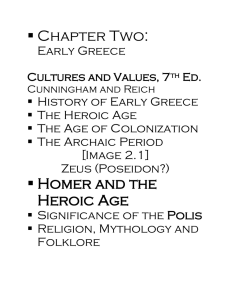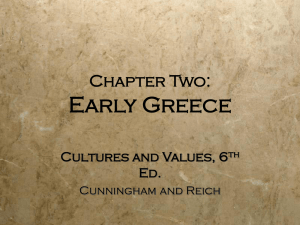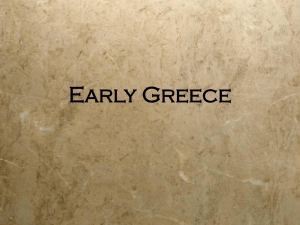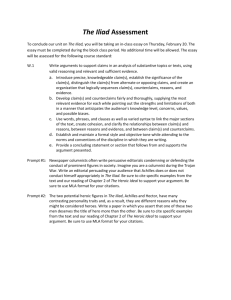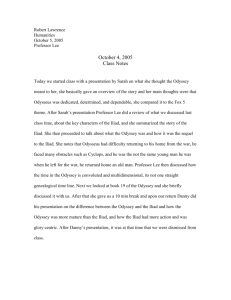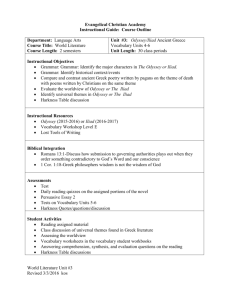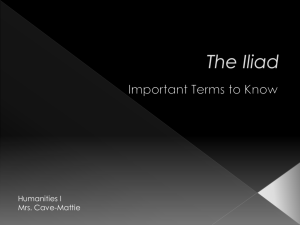Early Greece Attica, Peloponnesus, and Asia Minor
advertisement
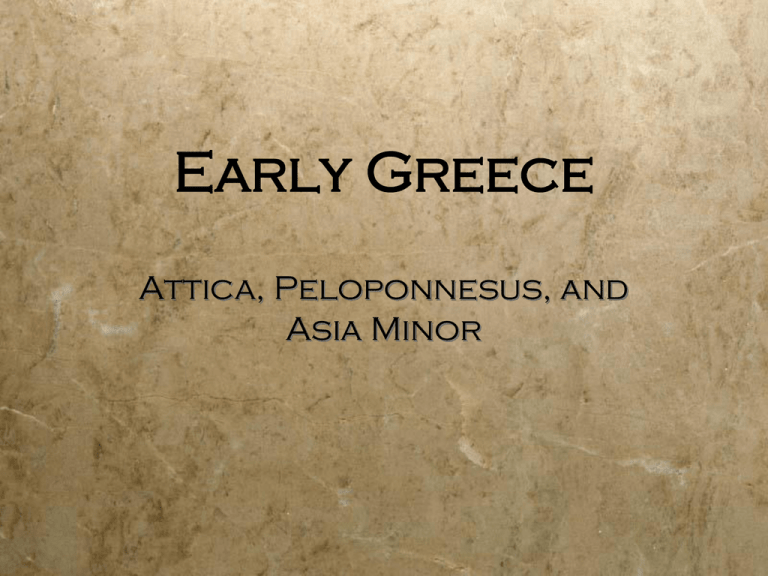
Early Greece Attica, Peloponnesus, and Asia Minor Ages of Early Greece 1. The Heroic Age 2. The Age of Colonization 3. The Archaic Period The Heroic Age Religious Worldview Civic (city-state deities) Private (chthonic deities) Urban Lifestyle Polis Agora Acropolis [Image 2.1] Zeus (Poseidon?) The Iliad & The Odyssey Heroic Verse / Epic Poetry “the Homeric question” Editor / Author Oral Tradition Epithets Iliad Theme of Human Responsibility Elaborate Similes Odyssey Return of the Epic Hero Iliad: Themes Anger War Glory Honor The Iliad Greeks: Achilles (Pain / Tribe-people) Agamemnon (Very Steadfast) Menelaus (Abide / The People) Helen (Torch / Venus”ish”) Patroclus (Glory of the Father) Trojans: Hektor (Holding Fast) Paris (Backpack) Priam (Exceptionally Courageous) Key Players: Thetis The Gods The Odyssey Story of Odysseus (Trouble) Odysseus’ journey home to Ithica Continues after the Trojan War Hero’s return despite trials Art and Heroic Age Society Painted Vases Protogeometric (1000-900 B.C.E.) Concentric circles semi-circles Geometric (900-700 B.C.E.) Linear designs the meander Human Forms (~800 B.C.E.) Age of Colonization Prosperity of City-States Status shown through Temple Art Wealth + Over-Population = Colonization Italy, Sicily, Egypt, Asia Minor Trade and Cultural Exposure Orientalizing Visual Arts at Corinth and Athens Trade Rivalry: Corinth vs. Athens Corinthian Art Eastern Motifs Commercially Successful Athenian Art Narrative style (Myth, Daily Life) The Archaic Period Tyrants Artistic Patronage Civic Pride Artistic Developments Freestanding Figures The “Archaic Smile” Vase Painting Black- Figure and Red-Figure Styles [Image 2.15] Euphronios, painter, Euxitheos, potter, red-figure calyx krater Beginnings of Greek Sculpture Heavy Egyptian influence Kore / Korai (Female) Kouros / Kouroi (Male) Increasing Realism, Naturalism Careful study of human anatomy Representation of Life and vigor Korous Kore The Doric Order Simple dignity “Classic” No Base Capital – plain Frieze triglyphs/metopes Pediment [Image 2.16] Basilica at Paestum The Ionic Order Ornate Style Base Capital – Volutes Running Frieze Poetry – Lyric Verse Sappho – d.~570BCE • Aristocratic Birth • Political upheaval common • Exiled from Lesbos to Sicily (Syracuse) c. 604594) • Similar to Plato and Socratic Love • Married / Daughter Historic Verse Herodotus (Father of History) History of the Persian Wars Right over Might Hubris “Man is the measure of all things, of the existence of those that exist, and the nonexistence of those that do not” Protagoras First culture to be human-centered. Pre-Socratic Philosophy Materialists Elemental properties to life Thales – water Anaxagoras – reason Pythagoranism Mathematics - underlying principle of the universe / moral life Pre-Socratic Philosophy Dualists One World of perfection – (unseen) One World of change – (temporal) Atomists Unchanging Reality consists of small unseen particles (atoms) in the void
